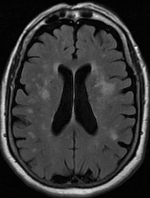


Leukoaraiosis is a particular abnormal change in appearance of white matter near the lateral ventricles. It is often seen in aged individuals, but sometimes in young adults. [1] [2] On MRI, leukoaraiosis changes appear as white matter hyperintensities (WMHs) in T2 FLAIR images. [3] [4] On CT scans, leukoaraiosis appears as hypodense periventricular white-matter lesions. [5]
